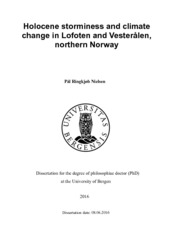| dc.contributor.author | Nielsen, Pål Ringkjøb | |
| dc.date.accessioned | 2016-06-09T12:22:18Z | |
| dc.date.available | 2016-06-09T12:22:18Z | |
| dc.date.issued | 2016-06-08 | |
| dc.identifier.isbn | 978-82-308-3317-9 | |
| dc.identifier.uri | https://hdl.handle.net/1956/12086 | |
| dc.description.abstract | This thesis investigates Holocene storminess and climate change reconstructed from lacustrine sediments from the Lofoten-Vesterålen archipelago in northern Norway (68–69°N, 12–16°E). The present thesis consists of an introduction and three individual papers in studying different perspectives of aeolian (wind) activity reconstructed from (I) glacier fluctuations, (II) coastal dunefield dynamics and (III) variations in aeolian sand influx from three different lake sediment basins. Paper I presents the first high-resolution late-Holocene glacier record from Lofoten. The study is based on glacial geomorphological mapping and analyses of sediment cores from lake Kveitvikvatnet (30.1 m a.s.l.), which currently receives meltwater from three small cirque glaciers. By combining selected sediment proxies to glacier advances of known ages, a continuous curve of the glaciers equilibrium-line altitude (ELA) over the last 1200 years has been constructed. This has further been connected to an independent proxy for summer temperature using the well-known ‘Liestøl- equation’, as well as the D/A-ratio, resulting in winter precipitation estimates throughout the recorded period. The extremely high sedimentation rates measured in the sediment cores (0.15–0.45 cm/yr) allow us to draw an analogy to instrumental data from nearby meteorological stations, which strongly supports our approach. We have identified that both the Medieval Climate Anomaly (MCA) and the Little Ice Age (LIA) were periods of high glacier activity in Lofoten. It is proposed that the advancing glaciers during both periods were caused mainly by an increase in winter precipitation, in relation to an increase in the strength of the westerlies. In Paper II we investigate the aeolian activity at a coastal dunefield on Andøya in Vesterålen. The study is based on a combination of geomorphological mapping, a lacustrine sediment record from the distal lake Latjønna (14.5 m a.s.l.) and a foredune stratigraphy. The lake sediment record was analysed by high-resolution measurements of sediment properties such as X-ray fluorescence (XRF), magnetic susceptibility (MS), grain size and loss-on-ignition (LOI). Aeolian activity was calculated based on the weight of sand grains >250 μm per cm recorded in Latjønna divided by the sedimentation rate. The two investigated sites show quite contrasting chronologies, where high sedimentation rates in the lake record, associated with more aeolian influx, correspond to stability in the foredune stratigraphy reflected by the presence of palaeosols. Phases with high influx of sand to Latjønna are recorded around 4800, 4250, 3000–2000, 1850–1750, 1600–600, 450, 300 and 150 cal. yr BP. Based on the investigated sites, it is suggested that a falling sea level made sand available for deflation, and that increasing storminess was the main driver for increased aeolian activity. The influx of sand to Latjønna is concurrent with other reconstructions from the region, thus recording variations in past storminess occurring in the NE Atlantic region throughout the last 6200 years. Paper III presents a reconstruction of aeolian activity (storminess) and mass-wasting events based on analysis of lacustrine sediment cores from lake Trehynnvatnet (33 m a.s.l.), which is located in a glacially carved valley at the outmost coast of western Langøya in Vesterålen, northern Norway. Sediment cores have been examined by use of various high-resolution proxies and firmly dated with 210Pb and 14C dating to detect changes in the depositional environment. In total, 35 event layers with a recurrence interval of ~300 years have been identified throughout the Holocene. The majority of these events are characterized as discrete coarse-grained sediment layers followed by normal grading and interpreted to be deposited by turbidity currents triggered by subaerial mass-wasting events. The continuous background sediments have been systematically investigated for the content of sand grains (>250 μm), which have been linked to catchment samples from a nearby beach located c. 750 m to the southwest. Based on the current wind regime and the local setting, the influx of wind-blown sand grains to Trehynnvatnet is suggested to reflect the strength, pattern and timing of storminess. The results show that storminess increased after 2800 cal. yr BP, with maximum influx of sand grains occurring during the Little Ice Age (LIA) period. The long-term trends shown in the influx of sand grains and mass-wasting events to Trehynnvatnet are similar to other reconstructions from nearby sites and from the NE Atlantic region. Hence, this record provides further knowledge about past regional scale changes in storminess and episodic extreme events throughout the Holocene. | en_US |
| dc.language.iso | eng | eng |
| dc.publisher | The University of Bergen | eng |
| dc.relation.haspart | Paper I: Nielsen, P.R., Balascio, N.L., Dahl, S.O., Jansen, H.L., Støren, E.W.N., Bradley, R.S. 2016: A high-resolution 1200-year lacustrine record of glacier and climate fluctuations in Lofoten, northern Norway. The Holocene. This article is not available in BORA. The published version is available at: <a href="http://dx.doi.org/10.1177/0959683615622551"target="blank">10.1177/0959683615622551</a> | eng |
| dc.relation.haspart | Paper II: Nielsen, P.R., Dahl, S.O., Jansen, H.L.: Mid- to late Holocene aeolian activity recorded in a coastal dunefield and lacustrine sediments on Andøya, northern Norway. This article is not available in BORA. The published version is available at: <a href="http://dx.doi.org/10.1177/0959683616640050"target="blank">10.1177/0959683616640050</a> | eng |
| dc.relation.haspart | Paper III: Nielsen, P.R., Dahl, S.O., Jansen, H.L., Støren, E.W.N.: Holocene aeolian sedimentation and episodic events recorded in lacustrine sediments on Langøya in Vesterålen, northern Norway. Submitted to Quaternary Science Reviews, December 3, 2015. Manuscript. This article is not available in BORA. | eng |
| dc.title | Holocene storminess and climate change in Lofoten and Vesteralen, northern Norway | eng |
| dc.type | Doctoral thesis | en_US |
| dc.rights.holder | Copyright the author. All rights reserved. | en_US |
| dc.identifier.cristin | 1372417 | |
